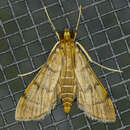pt-BR
nomes no trilho de navegação


Omiodes indicata, the bean-leaf webworm moth or soybean leaf folder, is a species of moth of the family Crambidae. It is found from Florida to Texas, the West Indies and Mexico to South America,[2] Cameroon, the Comoros, the Democratic Republic of Congo, La Réunion, Madagascar, Mauritius, Nigeria, Saudi Arabia, the Seychelles, South Africa,[3] India, Borneo[4] and Australia (Queensland).
The wingspan is about 20 mm.[5]
Omiodes indicata, the bean-leaf webworm moth or soybean leaf folder, is a species of moth of the family Crambidae. It is found from Florida to Texas, the West Indies and Mexico to South America, Cameroon, the Comoros, the Democratic Republic of Congo, La Réunion, Madagascar, Mauritius, Nigeria, Saudi Arabia, the Seychelles, South Africa, India, Borneo and Australia (Queensland).
 Larva
Larva  Damage
Damage The wingspan is about 20 mm.
Omiodes indicata est une espèce d'insectes de l'ordre des lépidoptères (papillons), de la famille des Crambidae.
Omiodes indicata se rencontre depuis le Sud des États-Unis jusqu'en Amérique du Sud[2], en Afrique[3], Moyen-Orient, le sud et sud-est de l'Asie[4] et en Australie.
Omiodes indicata a une envergure d'environ 20 mm. Sa couleur est brune ou jaune-brun avec des lignes de couleur plus foncée sur leurs ailes[5].
Ses chenilles sont considérées une peste pour le soja, mais elles se nourrissent aussi de Arachis (Arachis hypogaea), Beta vulgaris var. saccharifera, Calopogonium, Chrysanthemum indicum, Coleus, Gloriosa, Glycine max, Lantana camara, Nicotiana tabacum, Phaseolus (y compris Phaseolus vulgaris), Vigna unguiculata et Vigna vexillata.
Omiodes indicata est une espèce d'insectes de l'ordre des lépidoptères (papillons), de la famille des Crambidae.
Omiodes indicata is een vlinder uit de familie grasmotten (Crambidae). De wetenschappelijke naam van deze soort is voor het eerst geldig gepubliceerd in 1775 door Fabricius.
De soort komt voor in tropisch Afrika.
Bronnen, noten en/of referentiesOmiodes indicata là một loài bướm đêm trong họ Crambidae.[2][3]